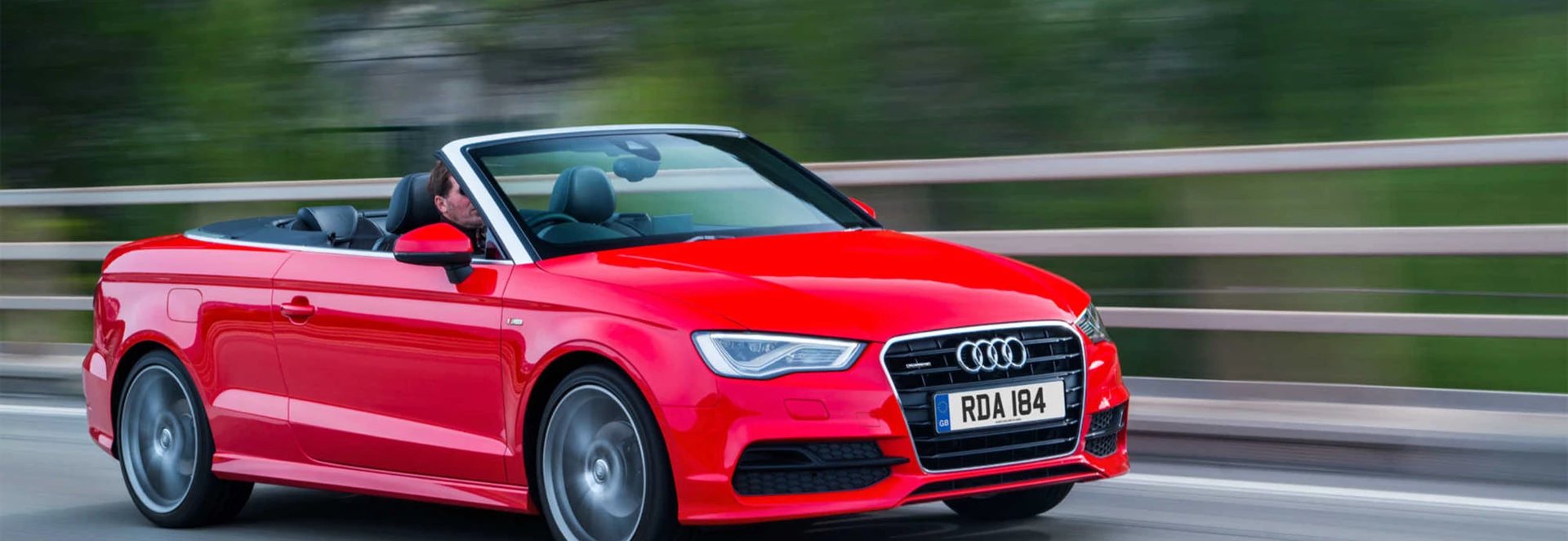Despite the notable lack of sun in Blighty, us Brits have a surprising propensity for convertible cars, with demand among the highest in Europe.
The Audi A3 Cabriolet, then, remains an important part of the extended A3 line-up for Audi. This second-generation model uses the rear end of the newly launched A3 saloon rather than the hatchback, making the proportions bigger.
The soft-top is 183mm longer than the previous-generation it replaces and 28mm wider, but with a 15mm reduction in height. This all no doubt contributes to what Audi calls “a coupe-like design”, as well as creating more passenger and boot space.
Still, it has also managed to reduce its weight, which is always a struggle in cabriolet-building, partly thanks to new manufacturing techniques and the use of aluminium for the shell. The entry-level car now weighs 1,440kg – that’s 30kg less than its predecessor.
Performance
We tested the 1.4-litre TFSI petrol engine with cylinder-on-demand, a clever piece of tech that shuts down the second and third cylinders when they’re not needed, such as when coasting, helping efficiency.
This entry-level petrol, which will make up around a third of sales, produces 138bhp and reaches 62mph in 9.1 seconds with a top speed of 135mph. And it’s a good fit with this car, proving a quiet, refined ride for a soft-top with plenty of power for most drivers. It lacks some grunt at the top end, but the average A3 Cab owner will be more than happy with this performance.
The second petrol iteration, the 1.8-litre TFSI with 178bhp, is the fastest in the range overall, promising 0-62mph in 7.8 seconds. While this is the gutsiest out there, it won’t sell particularly well, with less appealing efficiency and economy figures than its sibling.
We also had a go in the 2.0-litre 148bhp diesel, which will take about a quarter of sales and is the only oil burner available at launch. A 1.6-litre 108bhp diesel was later added to the range and is expected to match the 1.4-litre TFSI for sales.
Inevitably, the 2.0-litre TDI diesel is noisier than its petrol counterpart which is always more noticeable in a cabriolet, and this is definitely the case here. Acceleration is more than sufficient, hitting 0-62mph in 8.9 seconds with a top speed of 139mph, but the 1.4-litre TFSI is the top choice here, unless you’re doing a lot of motorway miles.
Ride and Handling
When that rarely sighted sun does appear, the canvas top retracts in 18 seconds via a switch in the central console, at speeds of up to 31mph.
The A3 Cabriolet is as familiar as any other Audi behind the wheel, with decent steering, albeit the sort that lacks a little feedback. With the soft-top up, the ride is refined and quiet, no doubt helped by some extra layers of insulation in the hood that come as standard on the top two of three trims. When that rarely sighted sun does appear, the canvas top retracts in 18 seconds via a switch in the central console, at speeds of up to 31mph. That also means you can quickly cover up again when some inevitable rain strikes. In its cabriolet guise, the A3 suffers from some chassis flex, which is always a struggle when engineering a soft-top model using a hatchback as a starting point, but it’s a small pay-off if you’re in the market for a premium compact cabriolet.
Interior and Equipment
The Audi A3 range currently consists of a Sportback, Sportback e-tron, Saloon and Cabriolet models – many of which come with sportier RS or S3 derivatives.
Audi interiors are typically luxurious and comfortable, with its multimedia controls very easy-to-use. Standard equipment across SE, Sport and S line specs include a fully automatic hood operation, 16-inch alloys, air con, a folding screen, iPod connection, DAB digital radio, Bluetooth and a light and rain sensor package. The S line trim on our test models added Sports suspension lowered by 25mm, cloth and leather seats, chrome tailpipes as well as LED lights. If you’re buying a cabriolet, you’re usually willing to sacrifice food-shopping and rear-passenger space. Audi has managed to increase boot capacity though over the previous model, with 275 litres with the roof down and 320 litres with it up, an increase of 60 litres.
Cost
The 1.8-litre TFSI will be the thirstiest, with Audi claiming combined fuel consumption of 48.7mpg and emissions of 133g/km.
The 1.4litre TFSI offers fuel economy of 56.5mpg and CO2 emissions of 114g/km, while the 2.0-litre diesel has more impressive costs with 67.3mpg and 110g/km. The 1.6-litre diesel is the most cost efficient, returning up to around 70mpg – according to Audi. The 1.8 TFSI will be the thirstiest, with Audi claiming combined fuel consumption of 48.7mpg and emissions of 133g/km. Starting prices for the A3 Cabriolet are a chunk less than the BMW 2 Series Convertible. It is however considerably more expensive than the VW Golf Cabriolet.
Our Verdict
Those who are after a convertible will want luxury, swarve appeal and decent driving dynamics. The A3 Cabriolet has that. The biggest downfall of this car is its hefty price tag, especially when compared to the starting price of a Volkswagen Golf Cabriolet. That aside, the Audi A3 Cabriolet capably meets expectations; the driving compromises of the soft-top and numbed feedback will be mostly imperceptible to the buyers that will make this car a success.




